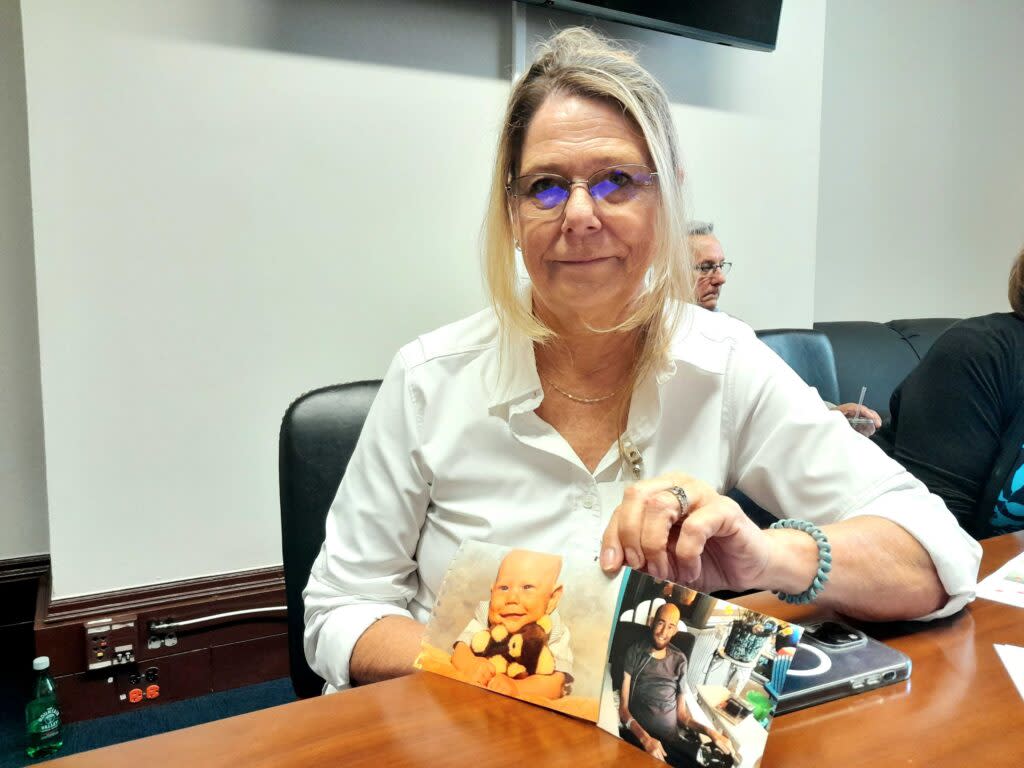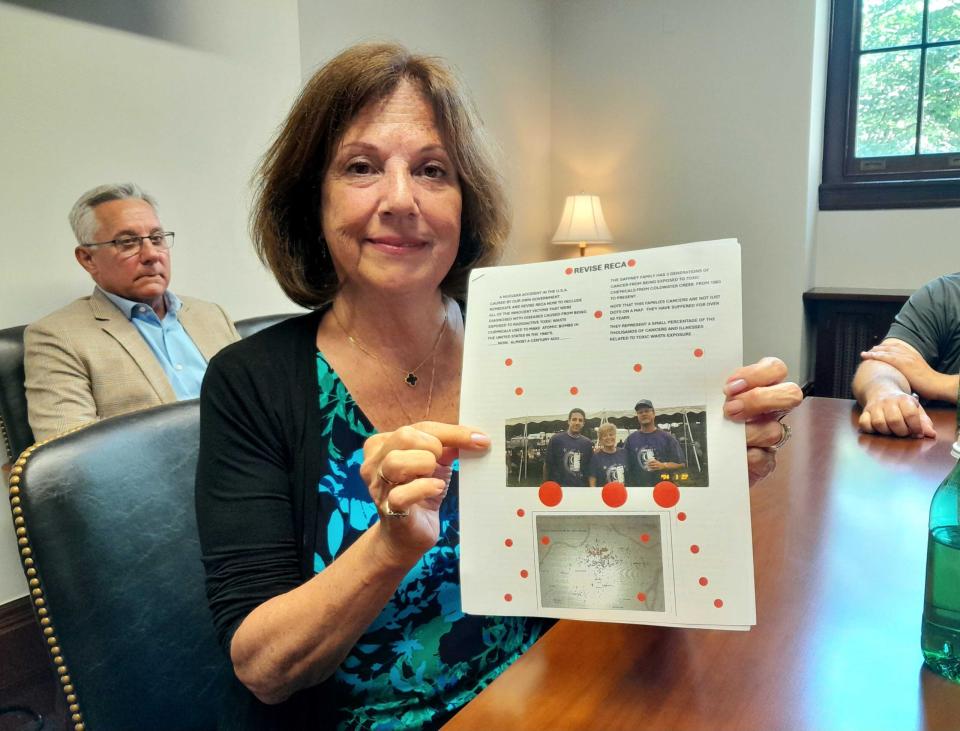People affected by radiation exposure push Congress to extend benefits

Tammy Tesson Puhlmann, 63, who now lives in Villa Ridge, Missouri, shows photos of her son Drew as she sat in the Russell Senate Office Building on May 22, 2024. Puhlmann’s son died of cancer at age 30, and she was among 10 eastern Missouri residents speaking to lawmakers on Capitol Hill about expanding the Radiation Exposure Compensation Act. (Ashley Murray/States Newsroom)
WASHINGTON — A fund to compensate Americans sickened by exposure to atomic bomb tests, uranium mining and radioactive waste expires in just under 20 days, and activists and lawmakers are scrambling to keep the fund active and open to additional victims.
A bill to reauthorize and expand the Radiation Exposure Compensation Act, often shortened to RECA, sailed through the U.S. Senate in early March on a bipartisan 69-30 vote, but the House has yet to take it up for a vote.
Critics cite high costs, but bipartisan lawmakers and activists rallying in favor of the bill say the victims have already paid the price through medical bills and lost loved ones, and that it’s ultimately the government’s wrong to make right.
The U.S. Senate-passed legislation, championed by Republican Sen. Josh Hawley, aims to extend the program by six years and expand eligibility to several new locations, including his state of Missouri where, over decades, residents witnessed numerous rare similar cancers among neighbors in and around St. Louis.
Chemical plants in downtown St. Louis and Weldon Spring, Missouri, processed uranium during the nation’s WWII effort to build the first atomic bomb. Radioactive waste from the plants were stored and dumped around the area.
States Newsroom’s Missouri Independent, in collaboration with the Associated Press and MuckRock, obtained and combed through thousands of government records that revealed the government downplayed and ignored the dangers of the radioactive waste.
SD Rep. Johnson signs letter urging vote
South Dakota Republican Dusty Johnson was one of eight signers of a letter to House leadership Friday urging a vote on the Radiation Exposure Compensation Reauthorization Act.
“Congress must not forget those innocent people who were irradiated and permanently impacted — simply because of where they lived or how they tried to earn a living for their families,” the letter says.
People who worked in South Dakota’s uranium mining, milling and transport industry decades ago in Edgemont are among those eligible for Radiation Exposure Compensation Act funding.
As of 2023, people living in South Dakota had submitted 114 claims to the fund since its inception, resulting in 37 denials, 76 awards and one claim that was pending. Total payouts to South Dakotans stood at $6.56 million.
When the reauthorization act passed the Senate in early March in a bipartisan 69-30 vote, South Dakota’s Republican senators split their votes, with Sen. Mike Rounds voting for it and Sen. John Thune against it. Neither of their offices provided rationale for their votes in response to messages from South Dakota Searchlight.
— South Dakota Searchlight staff
‘The government has done this’
Tammy Tesson Puhlmann, 63, who lived for decades in Florissant, Missouri, sat in the Russell Senate Office Building Wednesday showing photos of her son Drew — first, as a baby who was born with a rare blood disease, and then as a thin 30-year-old man just a week before he died of cancer.
“If I can prevent one mom from having to go through something like this, I would do anything,” she said through tears. “It’s the most unbearable feeling in the world to know that there is nothing you can do for your child, and to know that the government has done this.”
Puhlmann was among 10 eastern Missouri residents and state representatives who met with 10 lawmakers on Wednesday, including House Majority Leader Steve Scalise; U.S. Reps. Ann Wagner and Blaine Luetkemeyer, both Republicans of Missouri; and the state’s GOP Sens. Eric Schmitt and Hawley.
Missouri state Reps. Tricia Byrnes and Richard West, both Republicans, who represent districts just outside St. Louis, flipped through maps and photos documenting the contaminated sites, including where a uranium processing plant and byproduct dumping ground were located next to Francis Howell High School, which Byrnes attended.
“Look how close it was to all of the contamination. That high school is still there,” Byrnes said, pointing to a map.
To Byrnes’ left sat Kristin Denbow, a 1988 Francis Howell graduate who has been diagnosed with multiple myeloma, an incurable blood cancer in the bone marrow.
“We have memories of men in full containment suits walking around the grounds of our high school while we were there,” Denbow said.
‘This has been our lives’
Three generations of Susie Gaffney’s family made their homes in the suburbs of St. Louis near Coldwater Creek, unaware that radioactive waste relocated from the downtown uranium plant was leaking into the water.
Susie’s husband, Jim, grew up in a house beside the creek and not far from Jana Elementary School, which closed in 2023 because of radioactive contamination.
“Jim grew up playing in the creek, everybody did. Everybody who tells the creek stories played (there). It was awesome, it wasn’t deep. Kids fished, they made mudslides. It was a great place to live,” Gaffney said.
Jim, whose mother died of colon cancer after being diagnosed in her 40s, developed lymphoma at the age of 24.
When Susie and Jim’s son Joey was an infant, they moved to a nearby subdivision named Wedgewood, a few miles down the creek. Joey also played in the water as a child.
Joey was diagnosed at 18 with thyroid cancer and eventually underwent a thyroidectomy. Gaffney, now 66, recalls the doctors telling her, “This kid is Chernobyl.”
“‘This is what happened in Chernobyl. He has metastasized thyroid cancer. This is what happened there. He had to be exposed to radiation’ and naively I said, ‘Well, where?’ And so this has been our lives,” she said.
Joey is now 45. Jim, 68, was also diagnosed with bladder cancer and is now living with myelodysplastic syndrome, Gaffney said.
“He’s living on blood transfusions,” she said, pointing to a photo of him on a packet of papers she was handing out to lawmakers on Capitol Hill.
Below the photo of Jim was a map of the region with red dots for each cancer case.
“I just want people to tunnel in,” Gaffney said. “Pretend you’re on Google Earth, zoom all the way down and get on those front doors and picture our lifespan with health care, with depression, with anxiety, fear. Our quality of life has definitely been affected, all of us.”
Debate on Capitol Hill
The government’s nearly expired compensation program pays one-time sums of $75,000 to those who developed certain diseases after working on U.S. nuclear tests before 1963. It pays $50,000 to those who lived in select counties downwind from test explosion sites between January 1951 and October 1958, and the month of July in 1962, in Arizona, Nevada and Utah.
Uranium industry workers who were employed in 11 states from 1942 to 1971 and subsequently developed eligible illnesses qualify for $100,000.
Hawley’s bill, co-sponsored by Democratic Sen. Ben Ray Luján of New Mexico, would also expand to include the entirety of Arizona, Nevada and Utah, and include downwind and affected areas in Colorado, Idaho, Montana, New Mexico, and Guam. Additionally, the one-time compensation sums to victims or surviving family members would increase to $100,000.
If enacted, the legislation would reach areas including ZIP codes in Alaska, Kentucky, Missouri and Tennessee, where communities were impacted by radioactive waste dumping, uranium processing and other related activities surrounding the testing.
The bill’s estimated cost of $50 billion to $60 billion has drawn criticism. Hawley’s office confirmed the estimate. There is not an official budget score.
On Thursday, Sen. Mike Lee of Utah, asked for unanimous consent on the Senate floor for his proposed “clean extension” of the program as it exists for another two years — only covering those affected in areas of Arizona, Nevada and Utah.
Lee cited the risk of “inflating the deficit by at least $60 billion” and questioned whether enough data backs contamination in the additional areas in Hawley’s bill.
“You see, the House of Representatives has thus far declined to take up and pass Sen. Hawley’s previous bill, with some signaling concern and raising some of the concerns that I just restated,” the Utah Republican said.
Hawley objected, and Luján spoke in support of the objection.
“Study after study has shown the expanse of the nuclear radiation. Here is a study from 1997, from 2005, another from 2005, from 2023, all showing that the nuclear radiation is far beyond the contours of the original RECA bill passed in 1990,” Hawley said. “Yet my friend from Utah wants to keep doing the same old thing, leaving out in the cold hundreds of thousands of Americans. I will not consent to it.”
Lee responded, saying he understood the “impassioned pleas” from Hawley and Luján. He offered an updated version that includes Missouri and New Mexico, but leaves out other states and Guam. His office cites an unofficial budget score of $30 billion.
“There are other states in (Hawley’s) legislation pending in the House that deal with law in the Marshall Islands, Idaho, Kentucky, Ohio, Alaska, and perhaps one or two other jurisdictions. The claims of those states are not on equal footing,” Lee said.
“That is where a lot of the — not all, but a lot of the expense is accrued and a lot of concerns expressed in the House impeding its quick passage over there that might lead to it not being able to be passed at all,” he continued.
Hawley again objected, saying he “will not be party to any attempt at some halfway measure, some short stopgap bill, or some effort to sweep this under the rug.”
A spokesperson for House Speaker Mike Johnson, of Louisiana, told States Newsroom on May 15 that “The Speaker understands and appreciates Senator Hawley’s position and is working closely with interested members and stakeholders to chart a path forward for the House.”
RECA was established in 1990.
The U.S. conducted more than 1,000 atomic weapons tests from 1945 to 1992 — the first at the Trinity Test site near Alamogordo, New Mexico, where scientists detonated the Manhattan Project’s first atomic bomb prior to the U.S. dropping the weapons on Hiroshima and Nagasaki, Japan, at the end of World War II.
As of June 2022, the government has approved more than 36,000 RECA claims for more than $2.3 billion in benefits.
Unless the fund is extended, claims have to be postmarked by June 10, 2024, according to the Department of Justice, which administers the payouts.
GET THE MORNING HEADLINES DELIVERED TO YOUR INBOX SUPPORT NEWS YOU TRUST.
The post People affected by radiation exposure push Congress to extend benefits appeared first on South Dakota Searchlight.


